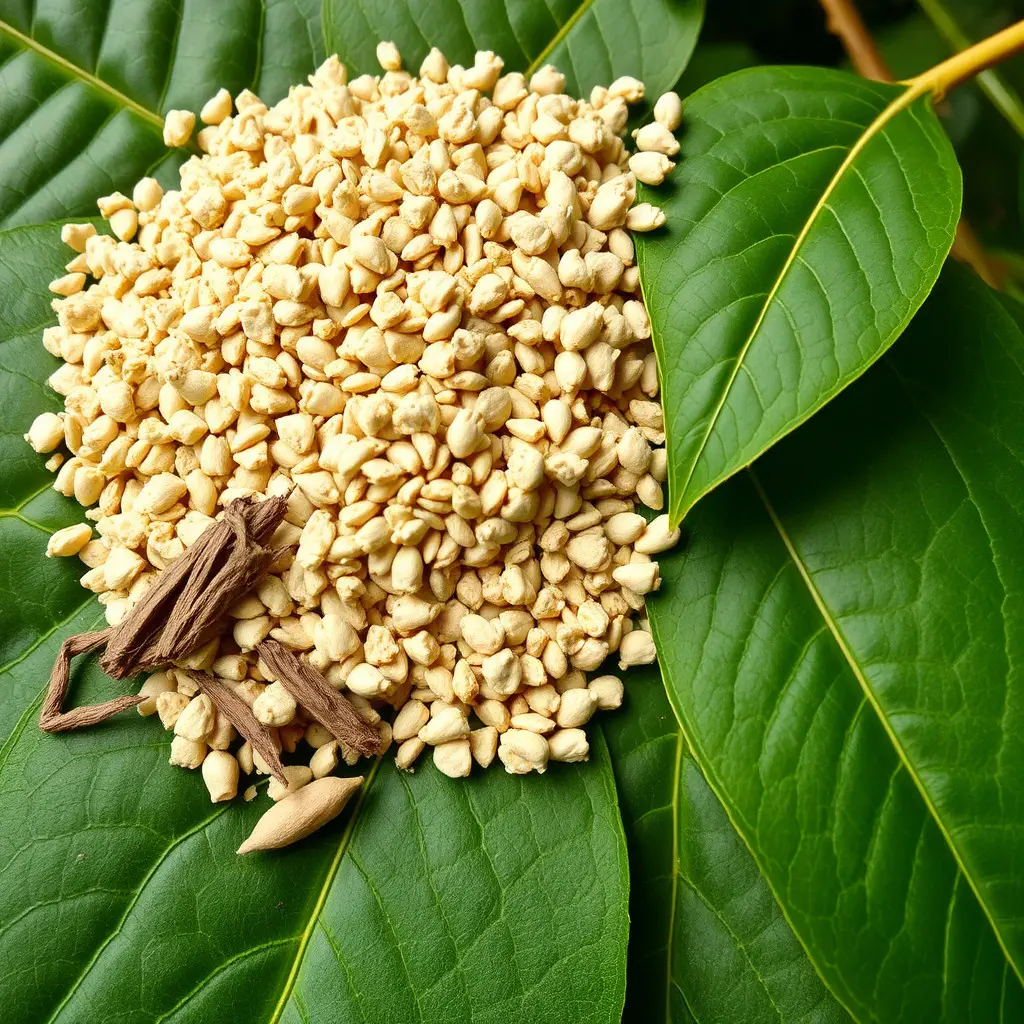Maeng Da Kratom, a strain from the Mitragyna speciosa tree, is known for its unique alkaloid profile that includes mitraphylline and a blend of 7-hydroxymitragynine and mitragynine, which differentiates it from synthetic alternatives like blue lotus. Its effects can range from stimulant to opioid-like due to these compounds. While Maeng Da interacts with the body's systems in a way that aligns with natural processes, its impact is influenced by dosage, geographic origin, and individual physiology. Users must be cognizant of how Maeng Da can affect drug test outcomes, particularly when it comes to blue lotus smoke drug tests, as kratom alkaloids are structurally similar to opiates and can lead to false positives. It's important for individuals to be aware of the legal status of Kratom in their jurisdiction and to understand the potential implications of its use on drug test results. A thorough grasp of Maeng Da's effects, both pharmacologically and legally, is essential for informed decision-making and responsible consumption.
discover the multifaceted nature of Maeng Da Kratom Powder, a botanical that has garnered attention for its alkaloid profile and effects. This article delves into the potency of Maeng Da, exploring its holistic benefits and scientific composition. Understanding Maeng Da’s influence on well-being is complemented by an examination of legal considerations and the implications for those who undergo drug testing, including scenarios that might trigger a blue lotus smoke drug test response. Join us as we navigate the intricacies of this complex plant and its impact on health and legal standing.
- Unraveling the Potency of Maeng Da Kratom Powder: A Holistic Approach
- Maeng Da Kratom Powder and Its Alkaloid Composition: A Scientific Perspective
- Navigating Legalities and Drug Test Considerations with Maeng Da Kratom Use
Unraveling the Potency of Maeng Da Kratom Powder: A Holistic Approach

Maeng Da Kratom, a potent strain derived from the leaves of Mitragyna speciosa, has garnered significant attention within herbal and botanical supplement circles for its purported effects. The alkaloid composition in Maeng Da, which includes mitraphylline, 7-hydroxymitragynine, and mitragynine, is believed to contribute to its unique properties. Unlike synthetic substances, Maeng Da Kratom engages with the body’s natural systems, offering a range of potential benefits that are distinct from chemically synthesized alternatives like the blue lotus, which also interacts with bodily receptors but must be approached with caution due to its psychoactive nature and implications for drug test outcomes.
The potency of Maeng Da Kratom is often a subject of debate among users and researchers alike. Factors such as dosage, strain origin, and individual physiology play critical roles in determining the experience of each user. It’s important to approach the use of Maeng Da with a holistic mindset, considering not only the direct pharmacological effects but also the broader context of one’s lifestyle and health practices. In this light, individuals should be cognizant of how this supplement interacts with other substances they may ingest, including those that could result in a positive blue lotus smoke drug test due to cross-reactivity or similar molecular structures. A comprehensive understanding of Maeng Da’s effects and its potential impact on drug tests is essential for informed decision-making within the framework of legal and responsible use.
Maeng Da Kratom Powder and Its Alkaloid Composition: A Scientific Perspective

Maeng Da Kratom, a strain of Mitragyna speciosa, has garnered significant attention for its distinct alkaloid composition and reported effects. Scientific research has identified over forty alkaloids in kratom, with mitragynine and 7-hydroxymitragynine being the most prominent. These two alkaloids are believed to contribute significantly to the plant’s pharmacological properties. Mitragynine, the primary alkaloid, is known for its stimulant effects at lower doses and opioid-like effects at higher dosages. Conversely, 7-hydroxymitragynine is reported to be around thirteen times more potent than morphine, which may account for some of kratom’s analgesic effects.
The alkaloid profile of Maeng Da Kratom also includes trace amounts of other notable compounds such as 9-hydroxymitragynine and speciogynine, which play a role in the plant’s unique interactions with the body’s systems. This complex blend of alkaloids is thought to influence mood, pain perception, and energy levels, contributing to the diverse experiences reported by users. From a scientific standpoint, the alkaloid composition of Maeng Da Kratom distinguishes it from other kratom strains and suggests potential for both therapeutic and recreational use. It is important to note that while alkaloid content can inform us about the potential effects, individual experiences may vary, and further research is needed to fully understand the mechanisms of action involved. Additionally, users should be aware that despite its unique composition, Maeng Da Kratom must be approached with caution due to regulatory status and potential for drug test interference, such as the blue lotus smoke drug test, which detects similar compounds in the kratom alkaloid family.
Navigating Legalities and Drug Test Considerations with Maeng Da Kratom Use

Maeng Da Kratom, a popular strain derived from the Mitragyna speciosa tree, has gained significant attention for its purported wellness benefits. As with any substance that affects an individual’s physiology, it is imperative to navigate the legal landscape and understand how its use may impact drug test results. Legally, the status of Kratom varies by region; while some areas have fully legalized it, others have implemented restrictions or bans due to concerns over its psychoactive effects. Users must thoroughly research and adhere to their local laws regarding Kratom consumption to avoid legal repercussions.
When considering drug test implications, it is crucial for Maeng Da Kratom users to be aware that, despite not being a controlled substance in many places, its metabolites can trigger positive results on standard opiate tests. These tests, commonly used in employment screening and legal contexts, may detect the presence of mitragynine and 7-hydroxymitragynine, the main alkaloids in Kratom, which are structurally similar to opiates. Therefore, individuals who consume Maeng Da Kratom should be cautious when undergoing drug tests, as a positive result may lead to misinterpretation and unwarranted conclusions. To mitigate this, users should communicate their Kratom use to the appropriate parties conducting the test, if applicable, and consider discussing the matter with a medical professional or legal advisor. In any case, understanding the implications of Kratom use in relation to drug tests is essential for those who partake in Maeng Da Kratom to ensure they are fully informed and prepared for any potential situations that may arise from its consumption.
In conclusion, Maeng Da Kratom Powder stands as a multifaceted subject that warrants attention from both scientific and holistic perspectives. Its alkaloid profile, which includes the mitragynine and 7-hydroxymitragynine, offers insights into its potency and potential effects. Users and researchers alike must consider the legal status of Kratom when exploring its properties, as well as the implications it may have on drug testing outcomes, such as those involving blue lotus smoke drug tests. As the body of research continues to expand, a nuanced understanding of Maeng Da Kratom will become increasingly important for informed decision-making and policy formulation in this evolving landscape.






